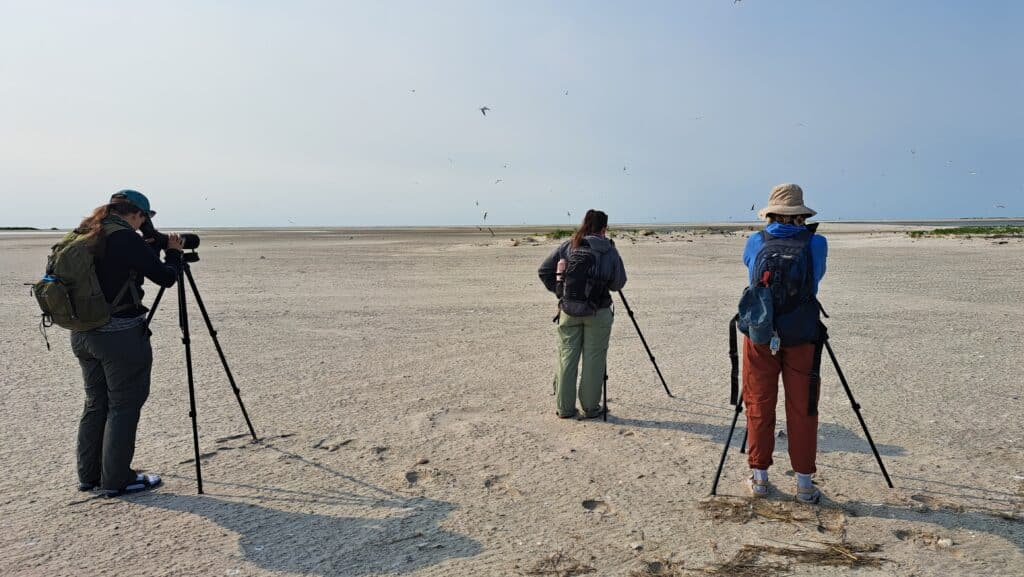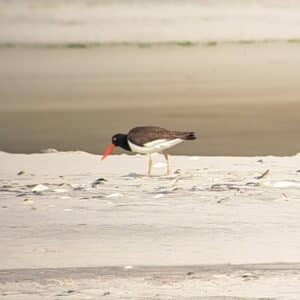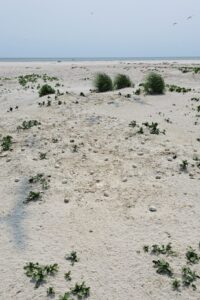Biologists on the Trail of Beach-Nesting Birds

Only a short boat ride off the coast of Little Egg Harbor Township lies an undisturbed haven for endangered beach-nesting birds. The shorelines of Horseshoe Island and Holgate are fully-stocked with piping plovers, black skimmers, and many signs warning boaters not to land on the protected islands. Members of the public are not allowed into these highly-restricted areas, and the only people allowed to step foot there are a small group of biologists.
Todd Pover, Senior Wildlife Biologist at CWF, and his team travel to these islands throughout the nesting season to keep an eye on nests and collect data on them. They work in partnership with New Jersey Fish and Wildlife and Edwin B. Forsythe National Wildlife Refuge to get access to the refuge and record information.
A day in the field starts with a visit to Horseshoe Island, a new and unique addition to the New Jersey off-shore landscape. What started as a small sandbar less than a decade ago has become a half-mile island that has been growing every year. While the new space is great for birds looking to start a family, the best part of the deal is that the island is free of mammalian predators like foxes, which are common nest destroyers.
The walk around the island takes the team a few hours to complete, even after dividing up the work. They venture from point to point, stopping where nests and mating pairs had previously been observed. Most of the focus for this trip is on American oystercatchers, a special concern beach-nesting species, and piping plovers, which are endangered. At each stop, the researchers look for eggs and chicks at the nesting sites so they can be logged and development can be tracked. Sometimes the nests are destroyed or the chicks don’t survive, and that is also recorded. All of this data is stored in a database so that the success of each generation can be measured over time.

Occasionally, the team will find a new nest, but the process is tricky. Sometimes, they’ll get lucky and the parents will be nearby, leading them right to the site, but other times, they have to follow tiny, sandy tracks to find the divots in the sand that beach-nesting birds scrape out for nests.
“It’s like being a detective,” said Madison Patterson, one of the biologists.
One of the joys of the work for the crew is finding that a previously unsuccessful pair of birds had renested. Many of the individuals on the island are banded, especially the American oystercatchers, so it makes it easier to identify which bird is which. For the plovers, not only do they get bands, but names, too. On Horseshoe, a male named Secretariat seems to enjoy scurrying around the island, using his camouflage to hide from the researchers. But, the professionals that they are, they find him anyway and add him to their logs.
By noon, it’s time to get back on the boat and head to the next stop: Holgate, a Unit of the Edwin B. Forsythe NWR. Unlike Horseshoe Island, this location does have mammalian predators, as well as a large population of endangered least terns. It also has the largest number of piping plover pairs in New Jersey.

All across the island, tern, skimmer, and plover eggs abound. Each step must be taken with the utmost care, as one wrong move can destroy a nest and take a toll on the next generation’s population size. That’s pretty serious: these species have been classified as endangered in the state for decades and the constant threat of habitat loss due to human activity makes it even harder for these birds to bounce back.
In the mid afternoon, the team finishes up their final bits of data collection and gathers back on the boat. As they return to the mainland, the sounds of squawking soften and the islands vanish into the distance. But they would not be gone long, for tomorrow would bring a new day, new trails, and new lives for the team to document.
For more information on CWF’s beach nesting birds project, visit our project page.
Discover more from Conserve Wildlife Foundation of NJ
Subscribe to get the latest posts sent to your email.

Leave a Comment
Thank you for all you do.
Great Work!!
Madison Patterson is my granddaughter !
Such a beautiful sight to see! Do you provide data on the changing size of the island from year to year ?
So proud of my granddaughter, Sarah Neil, helping with the conservation efforts of the team, in the very coastal estuary islands I explored as a young boy.
Comments are closed.